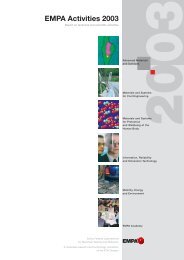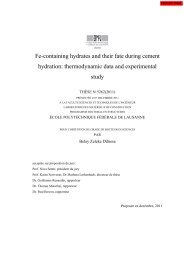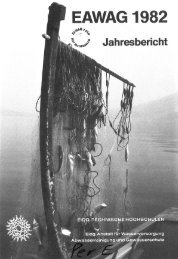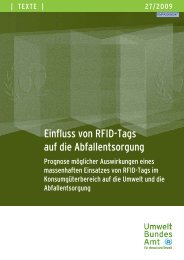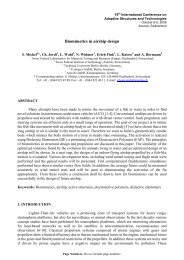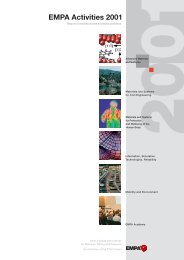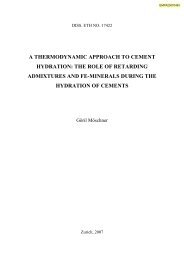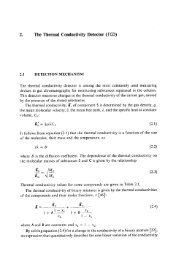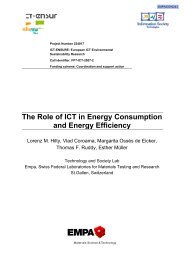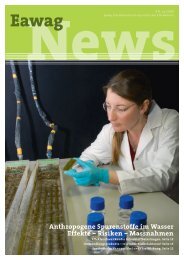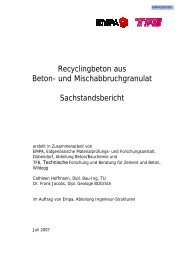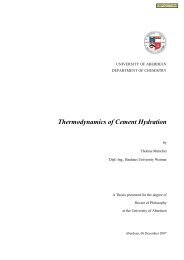Entire volume - Eawag
Entire volume - Eawag
Entire volume - Eawag
You also want an ePaper? Increase the reach of your titles
YUMPU automatically turns print PDFs into web optimized ePapers that Google loves.
of 10Be in ice cores from central Greenland,<br />
in which 10Be has been deposited from the<br />
atmosphere by precipitation, year by year<br />
and ice layer by ice layer.<br />
If the 14C concentration is dependent only<br />
on one variable, ocean mixing, then we<br />
should find constant deposition of 10Be in<br />
the Younger Dryas ice. If, however, also<br />
changes in the nuclide production rate are<br />
involved during the Younger Dryas, we<br />
should expect a variable 10Be concentration<br />
in the respective ice layers similar to the<br />
variations observed for 14C. Variable Production of<br />
10Be Isotopes<br />
It has in fact been possible to show through<br />
the analysis of 10Be data [5] that the radionuclide<br />
production rate, and, therefore,<br />
most probably also the solar activity during<br />
the Younger Dryas, was indeed variable<br />
(Fig. 1C). If one converts the 10Be data to 14C values, it appears that a large part of the<br />
atmospheric 14C variation can be explained<br />
by this variable rate of production (Fig. 3A).<br />
However, the 14C variations observed during<br />
the Younger Dryas can only be explained<br />
satisfactorily by including in addition the<br />
A<br />
Δ 14 C<br />
(‰)<br />
B<br />
Δ 14 C<br />
(‰)<br />
60<br />
40<br />
20<br />
13 EAWAG news 58<br />
0<br />
–20<br />
–40<br />
–60<br />
60<br />
40<br />
20<br />
0<br />
–20<br />
–40<br />
Younger Dryas<br />
effects of a 30% reduction in ocean circulation<br />
(Fig. 3B) [6]. Our analyses confirm,<br />
therefore, that the Younger Dryas is in fact<br />
associated with a reduced deepwater formation.<br />
The trigger for this abrupt climate<br />
change is still unclear. It is apparent, though,<br />
that the radionuclide production at the start<br />
of the cold phase was higher. This clue suggests<br />
that a reduced solar activity could<br />
have been the cause for the onset of the<br />
cold spell.<br />
With the example of the Younger Dryas, we<br />
have been able for the first time by comparison<br />
of 10Be and 14C data to distinguish<br />
between changes in the production rates<br />
–60<br />
14,000 13,000 12,000<br />
Age (years before present)<br />
12,000 10,000<br />
Fig. 3: Model of the atmospheric 14 C concentration (light-blue curves):<br />
A) taking only into account radionuclide production,<br />
B) taking into account both radionuclide production and ocean circulation.<br />
For comparison the actual reconstructed 14 C concentration is again represented (dark-blue curve from Fig. 1B).<br />
and changes in the carbon cycle. This<br />
process is usable for the whole time period<br />
covered by the 14C method (i.e. the last<br />
50,000 years), and will play an important<br />
role in future investigations concerning the<br />
global changes in the carbon cycle.<br />
Raimund Muscheler worked<br />
on this project as part of his<br />
doctorate in the “Surface<br />
Waters” department. Since<br />
2003 he has been working as<br />
a post-doctorate fellow at the<br />
University of Lund in Sweden.<br />
[1] Johnsen S.J., Clausen H.B., Dansgaard W., Fuhrer K.,<br />
Gundestrup N., Hammer C.U., Iversen P., Jouzel J.,<br />
Stauffer B., Steffensen J.P. (1992): Irregular glacial<br />
interstadials recorded in a new Greenland ice core.<br />
Nature 359, 311–313.<br />
[2] Stuiver M., Reimer P.J., Bard E., Beck J.W., Burr G.S.,<br />
Hughen K.A., Kromer B., McCormac G., Van der<br />
Pflicht J., Spurk M. (1998): INTCAL98 radiocarbon<br />
age calibration, 24,000 –0 cal BP. Radiocarbon 40,<br />
1041–1083.<br />
[3] Hughen K., Overpeck J.T., Lehmann S., Kashgarian<br />
M., Southon J., Peterson L.C., Alley R., Sigman D.M.<br />
(1998): Deglacial changes in ocean circulation from an<br />
extended radiocarbon calibration. Nature 391, 65–68.<br />
[4] Eddy J.A. (1976): The Maunder Minimum. Science<br />
192, 1189–1201.<br />
[5] Finkel R.C., Nishiizumi K. (1997): Beryllium 10 concentrations<br />
in the Greenland ice sheet project 2 ice core<br />
from 3–40 ka. Journal of Geophysical Research 102,<br />
26 699–26 706.<br />
[6] Muscheler R., Beer J., Wagner G., Finkel R.C. (2000):<br />
Changes in deep-water formation during the Younger<br />
Dryas cold period inferred from a comparison of 10Be and 14C records. Nature 408, 567–570.




